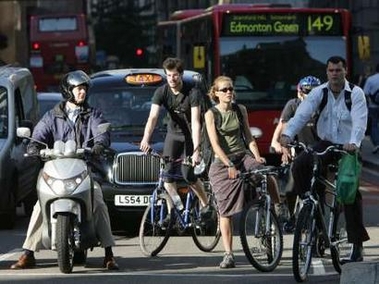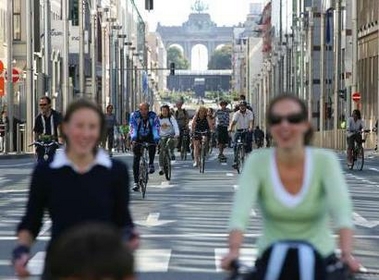Bicycling, in London and Brussells
 People cycle into the City during the morning rush hour in London, July 11, 2005. Police urged Londoners to get back to work on Monday to show the suspected al Qaeda bombers who killed at least 49 people on July 7 that they had not cowed the British capital into submission. REUTERS/Stephen Hird.
People cycle into the City during the morning rush hour in London, July 11, 2005. Police urged Londoners to get back to work on Monday to show the suspected al Qaeda bombers who killed at least 49 people on July 7 that they had not cowed the British capital into submission. REUTERS/Stephen Hird.USA Today reports in "London commuters opting to pedal to work" that bicycle commuting is increasing significantly in London, in large part post- the bombings on the London Underground, but also in response to the congestion fee for driving into the City.
According to the article: No hard figures are available on the number of cyclists in the city. A poll in 2003 found that 300,000 daily journeys are made by bicycle. The Transport for London office estimates cycling has increased 52% in the capital since 2000, based on the number of cyclists crossing bridges over the Thames River. Still, only 2% of Londoners cycle to work, compared with 20% in Copenhagen and 28% in Amsterdam. London Mayor Ken Livingstone, a bicycle enthusiast, wants to increase cycling 80% by 2010.
Also, Reuters (via photographs) reports on Brussels car-free day as part of "Mobility Week."
 Residents of Brussels ride their bicycles when the city centre was transformed in a car-free zone for a day as part as the 'Mobility week ' September 18, 2005. With cars banned from all 19 communes of the Belgium capital, only residents with special permission were allowed to drive their cars, and only then, at 30 miles (48 km) per hour. REUTERS/Yves Herman
Residents of Brussels ride their bicycles when the city centre was transformed in a car-free zone for a day as part as the 'Mobility week ' September 18, 2005. With cars banned from all 19 communes of the Belgium capital, only residents with special permission were allowed to drive their cars, and only then, at 30 miles (48 km) per hour. REUTERS/Yves Herman



0 Comments:
Post a Comment
<< Home